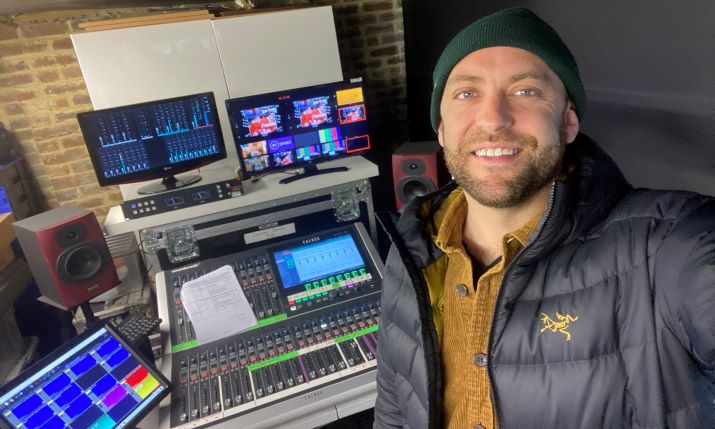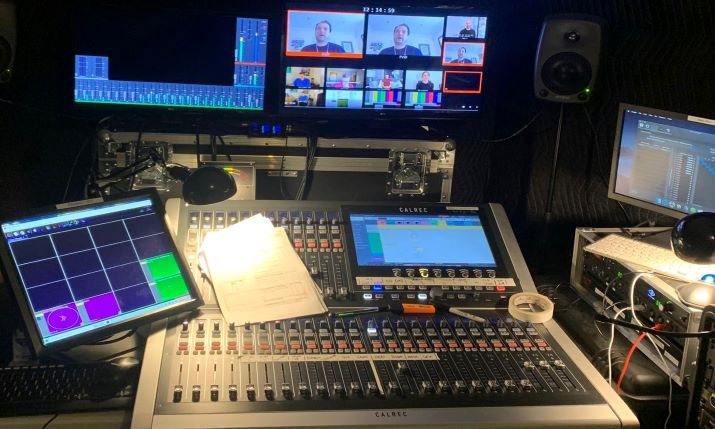Getting heard during lockdown on BT Sport’s The Greatest Race, Bundesliga and the Premier League

Tall Audio’s Paul Stadden in his garage during lockdown, working with Calrec Brio for BT Sport football coverage
During the UK’s first coronavirus lockdown, sound services company Tall Audio worked with BT Sport and Timeline TV on the broadcaster’s motorsport show The Greatest Race as well as on Bundesliga, Premier League and Early Kick Off show coverage.
Using innovative remote working techniques and some existing remote production skills, they helped their production partners to overcome what were very challenging production scenarios, using kit from Calrec.
Tall Audio, which has been around for 10 years, is owned by Alex Wrigglesworth and Paul Stadden.
Twist of fate
Motorcycling, specifically MotoGP, first for the BBC and for many years now with BT Sport, has been a mainstay of Tall Audio’s business. But then came COVID-19 and as for many, the impact was swift.
Wrigglesworth says: “I was doing a job for an advertising and marketing publication on a digital festival. It was the last job as COVID became a reality. We’d set up a de-rig studio at their location and then people joined in via the internet, rather than in the studio. That was the last week before lockdown. And we thought, hang on a minute…”
“Most of what we did was live. We had two mixers running, one as redundancy. This is a case of two people mixing simultaneously in case of an issue so any changeover would be seamless”
In a twist of fate, it turned out to be advantageous that the MotoGP season was very quickly postponed, allowing Tall Audio to tackle the overall situation head-on. Stadden says: “That’s when we spoke to Timeline Television. A director friend of ours told us about this technology they were going to use for parts of the Olympics (Timeline’s Stream Anywhere app) which became invaluable. We started chatting to Timeline and within a few days I had a talkback panel and a Unity Connect, which is public internet transport technology we’ve been using, to see if it worked over public internet for us.
“Timeline played a massive part in this. They are very experienced in remote production and this helped hugely when it came to remote working. Within a week or so, we handled a corporate internal job for BT Sport. Then quickly after that we pre-recorded a football show and then on the Sunday a live MotoGP show. After that it exploded.”
Stadden and Wrigglesworth were based in their respective home offices, also called their garages, both with a Calrec Brio and an AoIP Dante network.
Work and complexity
When working with Timeline TV on BT Sport’s lockdown projects, the pair took in embedded feeds, whether from an iPhone, Mobile Viewpoint hardware unit, satellite feed or an EVS system. These were then put onto a Dante network and sent across to Tall Audio via Unity, which can have up to 64 mono channels of audio.
Both live and as-live, prerecorded projects were carried out. Stadden worked mainly on the sports work that came in from the broadcaster. He comments: “Most of what we did was live. We had two mixers running, one as redundancy. This is a case of two people mixing simultaneously in case of an issue so any changeover would be seamless.
“I did the main mix using a Calrec Brio, which proved invaluable. Both Alex and I had a Brio for our work and, to be honest, they completely saved the day. It was a huge amount of work and complexity coming our way and the Brio’s simply handled everything that we threw at them. And using Dante was amazing.”

Paul Stadden’s garage-based set up for BT Sport was based around Calrec’s Brio and Dante
Tall Audio needed consoles that fitted the limited amount of space available, but that also gave them the edge in terms of broadcast quality and functionality. Stadden adds: “The routing capabilities of the Brio along with the ‘bird beater’ control (being able to open a fader that automatically mutes another send,) were invaluable. Without these, it [would have been] impossible to work as quickly and concisely as we needed to. You’re getting the power of a much larger desk in a small footprint. We also had good internet with low jitter and that was also crucial. I did all the Bundesliga live presentation matches from my garage. That is how robust it was.”
Managing the workflow
The embedded feeds would come in from BT Sport in Stratford, London, via Timeline in Ealing. Stadden would be controlling two commentators also working from home using Glensound Paradiso commentator units over IP (using Comrex). The audio was then de-embedded in Ealing and then via Dante audio, through a frame sync, to Stadden.
There was also a pitch side reporter at some games for BT Sport Premier League matches, which also went through the Brio in Stadden’s garage.
Stadden comments: “We streamed out onto the Unity but we also went via a Comrex interface as well, which is an IP codec. Our master output tended to go via the Comrex because it was a little bit more stable than the Unity. Also, because it was about delays in terms of comms, we wanted to be able to get the audio back as soon as possible. So the Comrex was primary, the Unity secondary. There’s an app called Unity Intercomm, which is a talkback app. So remote presenters would listen to the talkback app but also have a mic plugged into it.”
Timeline’s sound guarantees had to work extremely hard, routing all the video and comms audio from their homes. The routing matrix on a Calrec Apollo desk in Ealing was accessed remotely to route all the EVS feeds onto Dante lines to get back into Unity. The audio was remotely de-embedded and routed completely remotely, similarly with the intercom feeds.
The football – Bundesliga and some Premier League – was complex to work on because Tall Audio had to create three different mixes: a clean commentary, an effects mix and one with post-match interviews.
The Timeline TV sound guarantees in Ealing had to time the Dante and the Comrex output so that everything was in sync. “This was a real challenge with live football,” notes Stadden.
Stadden’s multiviewer was receiving feeds via the internet, which was then distributed to all the directors, EVS operators and the rest of those on each production working at home.
Stadden adds: “Of course you can’t check sync on that so there was someone quite talented sat in Timeline’s Ealing facility getting that lip synced. That’s fine with pre-recorded content but live? There were some long mornings of testing. The underlying thing is that with the Calrec Brios, we had consoles that did absolutely everything we asked of them. They were used pretty much every day for the 13 weeks [of lockdown before live sport returned], often for 10 hours a day, not in air-conditioned rooms; very far from it! They just worked, and they worked brilliantly with Dante.
“This also wouldn’t have happened without Timeline. We worked very, very closely with them to achieve this.”
As Stadden sums up, this is not the future, but it shows what can be done quickly and innovatively.

